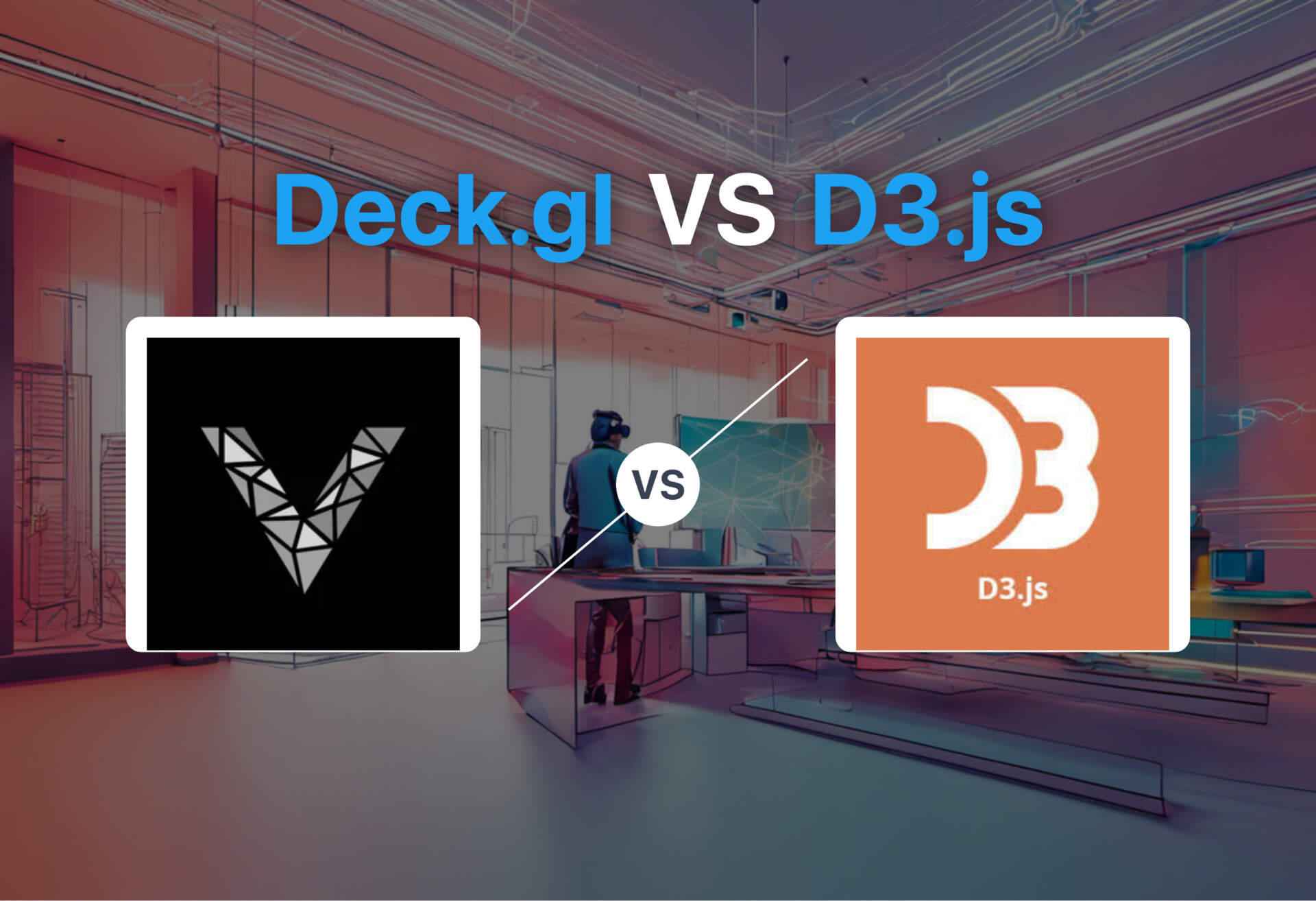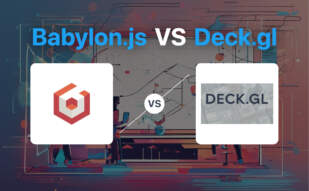For large-scale, customizable data visualization, deck.gl is tailored for you. It delivers high-performance WebGL2-powered rendering and incorporates multiple usage modes. However, if your intention leans more towards creating interactive, dynamic web browser data visualizations, D3.js with its emphasis on web standards and SVG graphics generation, is recommended.

Key Differences Between deck.gl and D3.js
- Deck.gl is primarily designed for large-scale data visualization while D3.js focus on dynamic, interactive web browser data visualizations.
- Data handling in deck.gl is made easy by a catalog of well-tested layers while D3.js utilizes data-binding for advanced usage with loaded data driving element creation.
- Deck.gl features interactive event handling such as picking, highlighting, filtering; D3.js manipulates elements based on data dependency.
- In terms of integration, deck.gl integrates with major basemap providers for cartographic projections, while D3.js operates on data and interacts directly with the DOM, harnessing web-standard benefits.
| Comparison | deck.gl | D3.js |
|---|---|---|
| Primary function | Data visualization tool designed for large-scale data | JavaScript library for dynamic, interactive data visualizations in web browsers |
| Framework | Utilizes WebGL2-powered layers composed from data (JSON) | Successor to Protovis framework, utilizes SVG, HTML5, CSS standards |
| Visual Elements | Icons, polygons, text views in map, first-person, orthographic | SVG graphics generation, text/graphical charts and diagrams |
| Data handling | Handles rendering/updating of large data, interactive event handling | Data binding, large datasets, transitions |
| Customizability | Highly customizable with flexible APIs, extendable core classes | Styling with CSS, element selection, SVG creation, style application |
| Usage modes | Script Tag, NPM Module, Pure JS, React, Python | Free, open-source library which uses web standards directly |
| Third-party integrations | deckgl-typings, mapdeck, vega-deck.gl, earthengine-layers, deck.gl-native, deck.gl-raster | Object styling using CSS, interpolation of values for attributes and styles |
| Learning tools | API docs, demos, interactive playgrounds (Codepen, Observable), Medium blog, Slack workspace | Dynamic, data-driven graphics authoring |
| Part of | vis.gl, under OpenJS Foundation | Data join concept for dynamic visualizations |
| Benefits | High-performance data visualization, integration with major basemap providers | Expressive framework focused on web standards, good performance, high control over visualization process |
What Is deck.gl and Who’s It For?
Deck.gl offers a high-performance, WebGL2-powered platform for large-scale data visualization. This JSON-supported tool provides a streamlined environment for developers to compose layers from massive datasets into visual representations like icons, polygons, text, and more. In terms of use-cases, deck.gl is a versatile instrument designed for data analysts, cartographers, and developers who require a tool to render visually appealing, insightful layers of substantial data.

Pros of deck.gl
- WebGL2-powered, high-performance visualization tool.
- Syntax friendly with JSON format
- Offers cartographic projections.
- Customizable APIs and core classes.
- Interactive features.
Cons of deck.gl
- Requires understanding of JavaScript.
- Limited default visual layers options.
What Is D3.js and Who’s It For?
D3.js, or Data-Driven Documents, is a low-level JavaScript library primarily designed for creating dynamic, interactive data visualizations on web browsers utilizing SVG, HTML5, and CSS standards. Building on web standards, D3.js targets data scientists, developers, and media organizations who require flexible and expressive visualization tools for web platforms. Overkill for private dashboards or one-off analyses, D3.js is renowned for authoring dynamic, data-driven graphics.

Pros of D3.js
- Supports a wide spectrum of data formats.
- Allows the implementation of large datasets.
- Provides smooth transitions for interpolate values.
- D3’s approach builds on web standards.
Cons of D3.js
- Low-level complexity.
- Can be an overkill for simple projects.
Deck.gl vs D3.js: Pricing
Both Deck.gl and D3.js are open-source data visualization technologies, available without charge.
Deck.gl
Deck.gl operates under the OpenJS Foundation and is a freely accessible, open-source technology, demonstrating an open-door policy to potential contributors.
D3.js
D3.js is also free; it stands as an open-source solution available for use by creators ranging from media organizations to individuals preparing bespoke, dynamic visualizations.
Code Examples for Deck.gl & D3.js
Deck.gl
This code demonstrates a Deck.gl Scatterplot Layer which displays geographical coordinates as points. Make sure you’ve installed Deck.gl via npm: npm install deck.gl.
import {Deck} from '@deck.gl/core';
import {ScatterplotLayer} from '@deck.gl/layers';
const data = [{position: [-122.45, 37.78]}]; // long, lat format
const myLayer = new ScatterplotLayer({
id: 'scatterplot-layer',
data,
pickable: true,
opacity: 0.8,
stroked: true,
filled: true,
radiusScale: 6,
radiusMinPixels: 1,
radiusMaxPixels: 100,
lineWidthMinPixels: 1,
getPosition: d => d.position,
getRadius: d => Math.sqrt(d.exits),
getFillColor: d => [255, 140, 0],
getLineColor: d => [0, 0, 0],
});
const deck = new Deck({
layers: [myLayer],
initialViewState: {
longitude: -122.45,
latitude: 37.78,
zoom: 12,
pitch: 0,
bearing: 0
},
controller: true
});D3.js
This plot uses custom scales to display a simple bar chart of data. Ensure D3.js is installed (npm install d3) and integrated into your environment.
import * as d3 from 'd3';
const width = 500;
const height = 300;
const margin = { top: 20, right: 20, bottom: 30, left: 40 };
const svg = d3.select(body).append('svg')
.attr('width', width)
.attr('height', height);
const data = [{"name": "A", "value": 9}, {"name": "B", "value": 4}];
const x = d3.scaleBand()
.range([margin.left, width - margin.right])
.padding(0.1)
.domain(data.map(d => d.name));
const y = d3.scaleLinear()
.domain([0, d3.max(data, d => d.value)]).nice()
.range([height - margin.bottom, margin.top]);
svg.append("g")
.attr("fill", "steelblue")
.selectAll("rect").data(data).enter().append("rect")
.attr("x", d => x(d.name))
.attr("y", d => y(d.value))
.attr("height", d => y(0) - y(d.value))
.attr("width", x.bandwidth());Deck.gl vs D3.js: Which Reigns Supreme?
As the titans of data visualization, Deck.gl and D3.js dominate the discussion, but which should you choose? Let’s dissect the audiences best served by each.
Data-Heavy App Developers
Deck.gl was designed for high-performance, large-scale data visualization, using WebGL2. If you are an app developer needing to handle rendering and updating of massive datasets, Deck.gl is your weapon of choice. Highlights include its flexibly customizable APIs, extendable core classes, and compatibility with multiple usage modes and third-party integrations.

Interactive Web Designers
For dynamic, interactive web designers — D3.js is your companion in complexity. Known for its fluid data-driven graphics authoring and wide array of data formats supported, D3.js gifts you control over the entire visualization process. If expressive, dynamic visualizations are your forte, there’s no better tool.

Data Science Academics
When academia meets technology, D3.js is a clear winner. Its origins from a background of influential data visualization practitioners and academics make it the ideal apparatus for advanced research needs in data science, where deep and extensive data manipulation is required.

React-Python Developers
Developers heavily veer towards Deck.gl. Its compatibility with multiple usage modes including React and Python, along with a robust set of learning tools, make it a steadfast choice. If high performance, customization, and comprehensive data visualization are your top priorities, Deck.gl satisfies your criteria.
In the battle between Deck.gl and D3.js, your choice hinges on your purpose. Deck.gl excels in managing large data, blending effortlessly with diverse platforms. On the other hand, D3.js harnesses the power of dynamic, interactive visualization, underpinning its usage in flexible scenarios. Ultimately, your project determines your pick.
Logan Bellbrook
Content writer @ Aircada with a knack for nature & AR/VR/XR. Blogging the intersection of tech & terrain.





